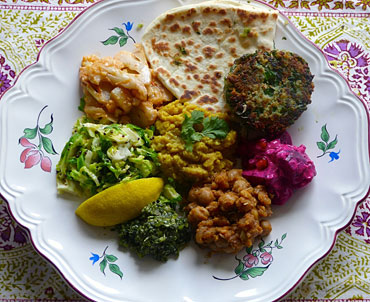
The Proven Platter | A Vegetarian Thali Platter
Hello Diners!
This month our culinary journey takes us to India, specifically the Maharashtra state in Western India. I got a little ambitious this month though, and rather than present you with one “proven platter” dish, I constructed an entire thali platter just for you! I had a lot of fun working on this project, and even more fun eating the leftovers for days!
Definition of Thali according to Wikipedia: “Thali, (meaning “plate”), is an Indian and Nepalese meal made up of a selection of various dishes. It simply means a round platter used to serve food. The idea behind a Thali is to offer all the six different flavors of sweet, salt, bitter, sour, astringent and spicy on one single plate. According to Indian food serving customs, a proper meal should be a perfect balance of all these six flavors. A fruit is often served at the end of meal.”
A thali plate could simply be a round platter around which small bowls (katori) of food are arranged, with the main starch placed in the middle of the platter. Or a thali plate could be a round or square platter divided into special segments or compartments; you know what I’m talking about if you’ve ever purchased a complete frozen dinner at the store – meat in one section, mashed potatoes in another, applesauce in another.
But of course you don’t need a specific plate in order to accomplish this. You can arrange your thali offerings in bowls on the table and let everybody help themselves, keeping in mind to put your rice or dal in the middle, and arrange small piles of the other offerings around the center. Typical offerings would include breads such as chapatti, roti, or naan; rice, dal, curried vegetables, chutney, pickles and a sweet dish to finish the meal.
The Etiquette of Eating the Thali
Spoon a small portion of food from an individual dish into the area next to the rice, and then combine it with the rice. Repeat this process accordingly with the rest of the dishes on the plate, but don’t mix more than one at a time. This enables the flavor of each dish to be appreciated individually. Chapattis are eaten with the food by using a piece of chapatti to scoop the food from one of the dishes.
Thali platters are hugely varied, depending on the regional preferences, seasonal produce and cultural expectations. For instance, in the Indian state of Maharashtra meat is used quite sparingly, due to culture and economic conditions, so I decided to go with a vegetarian thali. But feel free to replace anything on my recommended list with something else you would prefer. It all works.
See thali recipes on the website: Naan, Beets in Yogurt, Spinach and Potato Patties, Cauliflower Stew, Coriander Chutney, Brussles Sprouts with Black Mustard Seed, Chickpeas with Date Masala and Ghee.
Please feel free to contact me if you have any comments or questions at nw4@togetherwomenrise.org. I’d love to hear from you!
